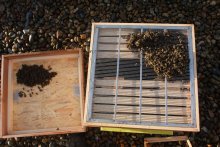Two swarms, but neither for me
Today I caught two swarms. It must be the weather.
Helen from my bee group is on holiday so I caught a very large swarm from one of her hives. It was tricky to catch. The swarm had settled around the trunk of a tree which had lots of stiff little branches. It was a little over 2m up.
- Read more about Two swarms, but neither for me
- Log in or register to post comments
